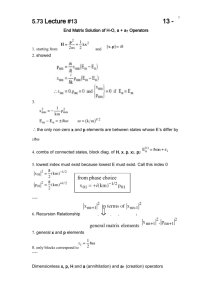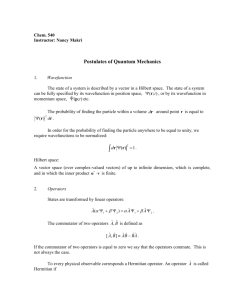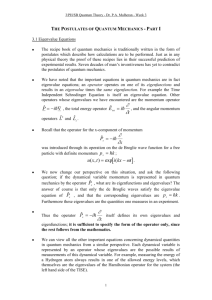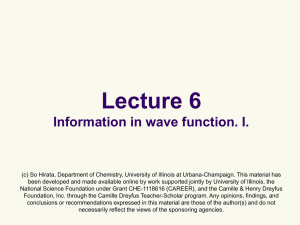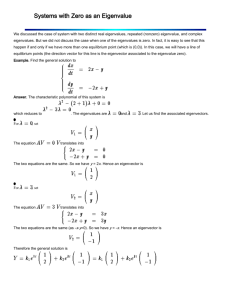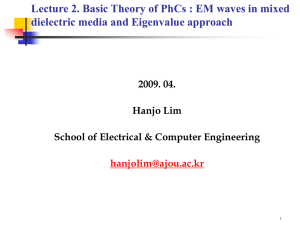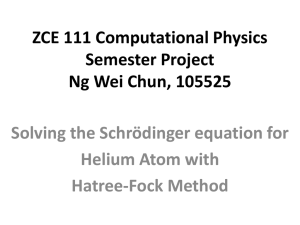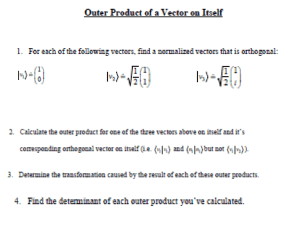QUANT OPERATORS
advertisement
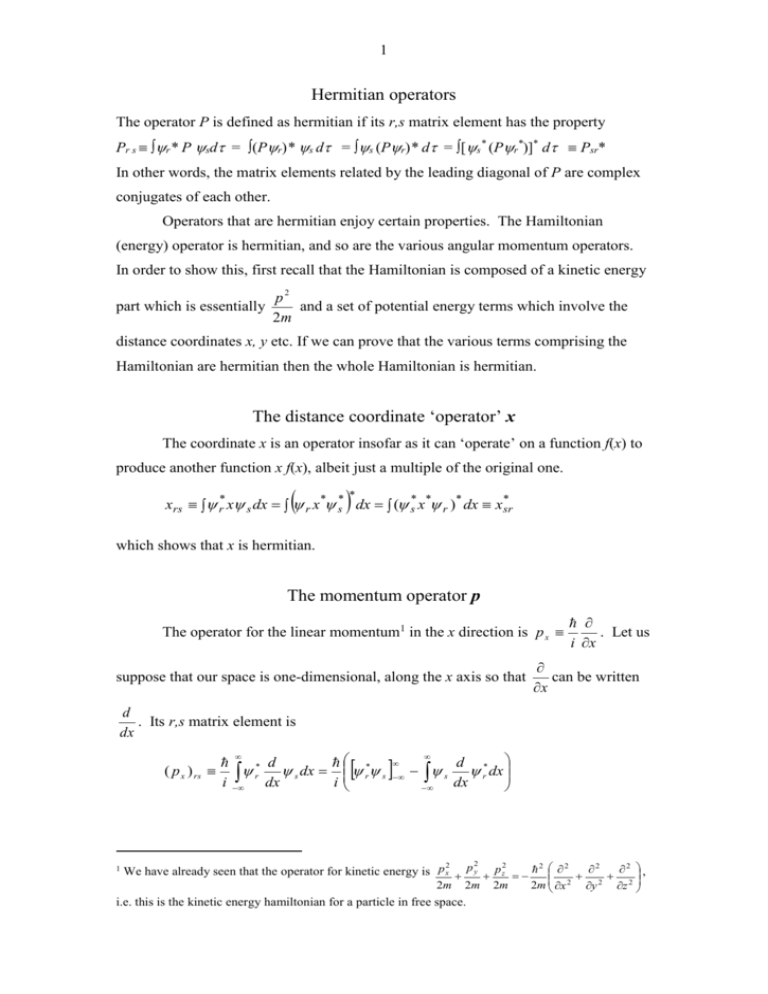
1
Hermitian operators
The operator P is defined as hermitian if its r,s matrix element has the property
Pr s ∫r* P sd = ∫(Pr)* s d = ∫s (Pr)* d = ∫[s* (Pr*)]* d Psr*
In other words, the matrix elements related by the leading diagonal of P are complex
conjugates of each other.
Operators that are hermitian enjoy certain properties. The Hamiltonian
(energy) operator is hermitian, and so are the various angular momentum operators.
In order to show this, first recall that the Hamiltonian is composed of a kinetic energy
part which is essentially
p2
and a set of potential energy terms which involve the
2m
distance coordinates x, y etc. If we can prove that the various terms comprising the
Hamiltonian are hermitian then the whole Hamiltonian is hermitian.
The distance coordinate ‘operator’ x
The coordinate x is an operator insofar as it can ‘operate’ on a function f(x) to
produce another function x f(x), albeit just a multiple of the original one.
*
xrs r* x s dx r x * s* dx ( s* x * r )* dx x *sr
which shows that x is hermitian.
The momentum operator p
The operator for the linear momentum1 in the x direction is p x
suppose that our space is one-dimensional, along the x axis so that
. Let us
i x
can be written
x
d
. Its r,s matrix element is
dx
d
( p x ) rs r* s dx r* s
i dx
i
1
s
d *
r dx
dx
2
2
2
2
2
2
2
We have already seen that the operator for kinetic energy is p x p y p z ,
2
2
2
2m
2m
i.e. this is the kinetic energy hamiltonian for a particle in free space.
2m
2m x
y
z
2
The first term is zero (wave functions of finite systems vanish at ) and the second
*
d
*
term is s* r dx which is p x sr . Therefore px is a hermitian operator.
dx
i
The Hamiltonian H
We could (but won’t!) extend the above treatment for px to show that its
square px2 is also hermitian so that the kinetic energy part of the Hamiltonian is
hermitian. If x is hermitian so also are y, z and r = (x2 + y2 + z2) and several
functions like
1
that depend on them and which appear as potential energy terms in
r
the Hamiltonian. Although this is not a complete argument its results strongly suggest
that the Hamiltonian operator is hermitian.
The bra and ket notation
It is convenient now to use the Dirac bra and ket notation to denote functions.
To explain their form suppose we wanted to write down the wave function for the 2p
atomic orbital for which ml = 1. Then instead of something like 2,1,1 we write
2 1 1 , which is called a ket. Then an eigenvalue equation involving the function
pa with eigenvalue previously written as Ppa = pa now becomes
P pa = pa
The normalisation integral of the function pa, i.e.
0
pa d is written
*
pa
pa pa where pa is the bra corresponding to the ket pa . The function
represented by the bra is taken to have been complex conjugated and associating the
bra and ket together in this way implies integration over all the whole range of the
variables. So the overlap integral Sab
element Vab
V
0
*
a
b
d as a V b .
Summarising,
a a
0
*
a
b
d is written as a b and the matrix
3
0
*
a
b
d a b
V
0
*
a
b
d a V b
Properties of hermitian operators
Their eigenvalues are real
To show this consider the eigenvalue equation involving the hermitian
operator P
P a = a
and multiply from the left with the bra a :
a P a a a
because a a = 1. But if P is hermitian the result would be the same if we were to
interchange the bra and ket and take the complex conjugate of the whole element:
= a P a = a P a *
*
So = *, i.e. the eigenvalue is real.
Since we have shown that the Hamiltonian operator is hermitian, we have the
important result that all its energy eigenvalues must be real. In fact the operators of
all physically measurable quantities are hermitian, and therefore have real
eigenvalues.
Their eigenfunctions are orthogonal
Consider the pair of eigenvalue equations for the hermitian operator P
P a = a
P b = b
and suppose that the eigenvalues are non-degenerate ( ). Now multiply (from
the left) the first equation by b and the second by a :
b P a b a
a Pb a b
4
But if P is hermitian b P a = a P b
*
and so
b a = * a b = a b
*
*
ba = ba
So
because is real.
*
because a b = b a
But as we have stated that the eigenvalues and are unequal, the only way the last
equation can hold is if
b a =0
i.e. the eigenfunctions are orthogonal ( a* b d 0 ).
0
What if a and b are degenerate?
If the eigenvalues and are equal the pair of equations is
P a = a
P b = b
And we define a ket A as a linear combination of a and b :
A = c1 a c2 b .
Applying the operator to A we get
P A = c1 P a c2 P b c1 a c2 a (c1 a c2 b ) A
showing that a linear combination of the degenerate states a and b is also an
eigenfunction of P, with the same eigenvalue . In quantum chemistry we often take
combinations of degenerate functions to produce functions which are more convenient
for the purpose2. As we have seen, in this case a and b are not necessarily
orthogonal, but combinations like A and B can be constructed using coefficients
c1, c2 etc. that ensure the orthogonality of A and B .
2
Recall the JS course where we made two combinations of the energy-degenerate complex 2p atomic
orbital functions 2p+1 and 2p1 by adding and by subtracting them to produce the real orbital functions
2px and 2py.
5
The commutation of operators
There are many sets of physical quantities (energy, momentum, position etc.)
describing quantum particles which may not be simultaneously measurable, i.e. it may
not be possible to specify simultaneous values to more than one of them at a time.
They are defined by the various equations describing the Uncertainty Principle, but
just which pairs of quantities A and B are related by A B are shown by the
operators concerned. If a state has exactly determinable quantities P and Q which
have operators P and Q so that
P p
and
Q q
then the following theorem can be proved:
Theorem: A system that is specified by a set of states 1 , 2 , has simultaneously
and precisely specifiable quantities P and Q if and only if their operators P and Q
commute i.e. P Q Q P , for all the wave functions .
There are two statements to be proved:
(a) For P and Q to have a common set of eigenfunctions they must commute.
Let one of the common eigenstates be represented by m in the eigenvalue equations
P m pm
Q m qm
Operate on the first equation with Q and on the second with P:
and
Q P m p Q m pq m
P Q m q P m pq m
Therefore P and Q commute, i.e. P Q = Q P.
(b) If P and Q commute they must have a common set of eigenfunctions.
This is the more useful statement. Suppose that m is an eigenfunction of P with
eigenvalue p:
P m pm
Operate on this equation with Q:
6
Q P m pQ m
Because of commutation we can write it as
P Q m pQ m
P [Qm] = p[Q m ]
i.e.
This equation implies that Q m is an eigenfunction of P with eigenvalue p. But the
only way that this can be the case is if m is an eigenfunction of Q. Therefore m
must be an eigenfunction of both P and Q operators.
Application in quantum chemistry – Symmetry operators
Here is a simple Hamiltonian. It is for the H2 molecule with two nuclei a and
b and with two electrons 1 and 2, but a Hamiltonian for any atom or molecule would
have the same sort of terms.
H=
2 2
e2
1 22
2m
40
1
1
1
1
1
1
ra1 ra 2 rb1 rb 2 r12 rab
2
2
2
You recall that the Laplacian operator is
for the first electron and
x12 y12 z12
has a similar form for the second, with 2 replacing 1. Now switching the nuclei a and
b and the electrons 1 and 2 means performing a symmetry operation (call it P) on the
molecule. But notice that the effect of these interchanges leaves H unaffected. So
if the product P H is applied to a wave function we can write the operation as
P (H )= H (P)
with P bypassing H to act directly on . But this means that P and H commute, and
so should have common eigenfunctions. What does this mean?
Staying with our H2 molecule recall that if there were no symmetry we would
write its molecular orbital wave function as
c11 c2 2
but when the values of c1 and c2 are found that make this an eigenfunction of H by
applying the variation principle we get the pair
1
1
2
1 2
7
and
1 2
2
As eigenfunctions of the hermitian operator P we have seen that 1 and 2 are
2
1
orthogonal. If you have any doubts on this, check it out:
<1 P 2 > = 1* P 2 d = ½(1 + 2)* (2 1) d
= ½[12 d 22] d 1*2 d + 2*1 d ]
= ½[ 1 – 1 –0 + 0]
=0
But since 1 and 2 are also eigenfunctions of H, matrix elements Hrs that they
form with H will similarly be zero:
<1 H 2 > = 0
This is a very important result – one which deserves to be expressed verbally:
If eigenfunctions of H 1 and 2 are found which are simultaneously
eigenfunctions of a commutinmg operator P that correspond to different eigenvalues
of P then the matrix elements that they form with H are zero.
This is the basis of the powerful methods of symmetry theory to reduce the
labour of quantum calculations and to symmetry-classify molecular wave functions
and states. In the simple example illustrated above we don’t need to calculate the
coefficients c1 and c2 by solving a second-order determinant, because they have been
obtained by making an eigenfunction of P. For the same reason, the application of
symmetry arguments to the MOs of pentalene C8H6 in our JS course enabled us to
avoid solving an 8th order determinantal equation and instead to solve separately one
3rd order, two 2nd order and a 1st order equation (3 + 2 + 2 + 1 = 8).
Consider what would happen if you tried to form matrix elements of H using
1 and 2. Just as 1 P 2 = 1. 1 2 which is zero because of the
orthogonality of 1 and 2, so also 1 H 2 = . 1 2 = 0 and the
Hamiltonian (energy) matrix is
0
E
0
E
8
i.e. the secular determinantal equation is
E
0
0
E
0
The matrix elements of H between different eigenstates of P are zero. The
Hamiltonian matrix has been brought to a diagonal form, or ‘has been diagonalised’.
Recall the application of symmetry in the MO treatment of pentalene
(JS symmetry course)
The MOs of the pentalene molecule transform according to symmetries A1, A2, B1
and B2 in point group C2v, and we showed that they were
(A1)
(A2)
(B1)
(B2)
= c1½(1 + 3 + 4 + 6)
= c1’ ½(1 – 3 + 4 – 6)
= c1” ½(1 + 3 – 4 – 6)
= c1”’½(1 – 3 – 4 + 6)
+ c2 ½(2 + 5)
+ c2” ½(2 – 5)
+ c7½(7 + 8)
+ c7”’½(7 – 8)
A symmetry orbital like (A2) does not interact with an orbital with different
symmetry like (B2). In other words the matrix element < (A2) H (B2)> is zero,
as we’ll demonstrate. In recognising the interactions between atomic orbitals at the
Hückel level remember that all parameters for non-nearest neighbours are zero.
< (A2) H (B2)>
= [c1’ ½(1 – 3 + 4 – 6) H c1”’ ½(1 – 3 – 4 + 6) + c7’”½(7 –
8)]d
= c1’c1”’ (1/4)[ + – – + 0 + 0 . . . ] + (1/22) c1’ c2”’ [ + – – + 0 .
+ 0 . . .]
=0
9
So the H matrix elements between functions corresponding to different symmetries
(here A2 and B2) are zero. It is for this reason that we can treat the four symmetries
A1, B1, A2 and B2 separately.
If an operator P can be found which commutes with operator H (e.g. Hamiltonian)
then any pair of non-degenerate eigenfunctions 1 and 2 of P produce zero matrix
elements of H.
i.e.
if
HP = PH
and
Pi = ai
then
*
i
and
Pj = bj
H j d 0
Angular momentum
By considering the form of the operator for the z-component of the angular
momentum operator l z
it is possible to show that l z (but not simultaneously
i
l x or l y ) commutes with the Hamiltonian H. So eigenfunctions of l z are also
eigenfunctions of H. As a result, just as the matrix elements of l z formed from
different eigenstates r and s of are zero, so also are the corresponding matrix
elements of H. (i.e. r l z s = 0 and r H s = 0). We shall use this property later.
Matrix form of the Schrödinger equation
1. Solutions of the Schrödinger equation
Select a solution to H = E which can be expressed as a linear combination
of a complete set of basis functions {i }:
= c11 + c22 + c33 + . . .
(1)
Since the set {i }:is complete the set {ci }of coefficients can be chosen to render so
flexible that it can constitute a solution (the kth, say) of the Schrödinger equation for a
particular system. Inserted into the equation the latter would read
10
Hk = Ekk
(2)
There are n independent ways of combining the n functions according to eqn. (1), so
k is a member of n solutions like those in eqn. (2). For the moment let us consider
just the kth solution: then eqn. (1) needs to be written bearing a label on the left hand
side and on the set of coefficients{ ci }:
k = c1k1 + c2k2 + c3k3 + . . . + cnkn
(3)
The { ci } are calculated using the Variation Principle (energy minimisation), which
entails solving the secular equations.
2. The Hamiltonian matrix
In order to solve for k and Ek in eqn. (2) the energy (Hamiltonian) matrix H
is constructed, whose general element is given by Hij ∫ I* H j d. Obviously the
elements of H depend on the basis functions {i } used to build it. Any other set of
functions, even if complete, would give rise to different matrix elements Hij' and
therefore to a different matrix H', although the energy eigenvalues obtained from H
and H' would be identical.
Example: The allyl radical at Hückel level
Using the carbon 2pz atomic orbitals as basis functions, the energy matrix for
the allyl radical,
1
2
3
H2CCHCH2 is
H
0
is
0
(5)
The π MO functions and energy eigenvalues for allyl are given in the table:
k
k
Ek
1
½ (1 22 + 3)
2
2
3
1
/2(1 3)
½ (1 + 22 + 3)
+ 2
11
Now instead of using the atomic orbital set (1, 2, 3) as basis functions what if we
had used the molecular orbital set to construct H? Let’s try:
H11
= ∫ 1* H 1 d = ¼ ∫(1 22 + 3)* H(1 22 + 3) d
= ¼[ + 2 + 2 2 2 2]
= 2
H22
= ∫ 2* H 2 d = ¼ ∫(1 3)* H(1 3) d
= ½ [ + ]
=
Similarly,
H33
= + 2
H12
=
1
2 2
2 2
=0
Similarly,
H12
=0
and
H23
=0
So the H matrix generated by the MO basis set {k} is
- 2 0
0
H
0
0
0
0 2
(6)
A comparison of the matrices defined in eqns. (5) and (6) shows that the latter differs
from that in (5) by the fact that the non-zero elements are confined to the diagonal
positions Hii, while Hij = 0 for i j. This H is a diagonal matrix. Using H given by
(6) to form the secular determinantal equation produces
- 2E
0
0
0
0
E
0
0
0
2E
which shows that the diagonal elements in H are already the energy eigenvalues E1,
E2 and E3 that were listed in the table. A process which transforms a matrix like the
12
one in eqn. (5) into a diagonal form as in (6) is said to diagonalise the matrix, thereby
revealing the eigenvalues of the matrix in its diagonal positions.
3. Vector notation
The linear combination in eqn. (3) may be written as a scalar product of two
vectors ck and where the underlining means that the quantity is a vector. If the basis
set defining k in eqn. (3) has n terms, the vectors ck and are each rows or columns
of n elements, and allow an alternative expression for k as
k = ck
= c1k1 + c2k2 + c3k3 + . . . + cnkn
To get the second of these equations from the first we form the scalar product of the
vectors ck and by supposing ck to be a row vector and a column vector, and then
using the rules of matrix multiplication. For clarity we’ll adopt the convention that a
vector with elements (x1, x2, . . . ) will be written as x if it is a column vector, but as
x† if it is a row vector. Doing this transposes a column vector x into a row vector x†,
and transposing x† again to x†† (= x) restores the column vector. Note however, that
as well as turning the column into a row format, converting x into x† also replaces the
components xi by their complex conjugates xi*. We also define the transpose A† of a
matrix A as one in which the rows have been swapped by the columns and vice versa,
and also complex-conjugated. In other words if the general element of A is Aij, it
appears in A† as Aji*.
Using this notation the above kth state function becomes
k = ck†
(7)
4. Matrix form of the eigenvalue equation. Part 1: the eigenvector matrix.
The energy Ek of the state k is normally calculated via the secular equations,
which furnish both these quantities, but if k is known, Ek may be extracted from it by
calculating
Ek
= ∫k* H k d
=
c
i
j
*
ik
c jk i*H j d =
c
i
j
*
ik
c jk H ij
13
So Hij i*H j d is the (i, j)th element of a matrix H. But using vector/matrix
notation the same can also be written
Ek = ck† H ck
(8)
Ek =
Check that this expression follows the rules of matrix multiplication of the three
factors on the right of (8): the dimensions of the first (a row vector) are 1 n, the
second is a n n matrix and the third is a column vector with dimensions n 1. The
result is therefore the scalar (single number) Ek.
Until now we have considered just one solution of the Schrödinger equation
the eigenvalue Ek and the eigenvector ck. But can the whole set of solutions be
handled simultaneously? Let’s assemble all the eigenvectors like ck into a matrix c,
whose order will be n n:
c11 c12
c 21 c 22
c
c32
c 31
.
.
.
.
c
n1 c n 2
. . . c1n
. . . c2n
. . . c3n
. . . .
. . . .
. . . c nn
(9)
The columns of c are the set {ck}, which are the eigenvectors associated with the
energy eigenvalues E1, E2, etc. The matrix c is called the eigenvector matrix, or
matrix of eigenvectors, and it has some special features.
5. Properties of the eigenvector matrix
The eigenvector matrix is an example of a type of matrix described as unitary.
A unitary matrix A has the following important properties:
1. The sum of the squares of the elements of any row or column is one,
i.e.
A
ij
j
2
1 and
A
2
ji
1
j
2. The scalar product of any two rows or of any two columns is zero,
14
i.e.
A
*
ij
Akj 0 and
j
A
*
ji
A jk 0
j
3. The transpose of the matrix is equal to its reciprocal,
i.e.
A† = A1
so that
A† A = I
(10)
where I is the unit matrix which is a matrix of the same dimension as A, with all its
diagonal elements equal to unity and all off-diagonal elements equal to zero.
1 0 0 . .
0 1 0 . .
I . . . . .
. . . 1 0
. . . 0 1
A unit matrix I multiplying any other matrix P leaves it unchanged (I P = P). If you
think of A (or c) as a matrix of LCAO coefficients, properties 1 and 2 follow from the
normalisation of the MO wave functions and from the orthogonality of a pair of MO
functions, respectively.
4. The eigenvector matrix c is such a unitary matrix. An important property
of c is its ability to diagonalise a matrix. This means that if the hamiltonian matrix H
is subjected to a similarity transformation with its eigenvector matrix c as follows:
c1 H c = c† H c = Ed
the resulting matrix Ed is diagonal, i.e. its off-diagonal elements are zero. Those
which are on the diagonal are the eigenvalues E1, E2, E3 , . . . of H,
i.e.
E1
0
E
0
0
E2
0
0
0
E 2
The procedure of finding the eigenvalues of a H matrix is often referred to as
‘diagonalizing’ it by finding a suitable matrix c to perform the similarity
transformation c† H c.
